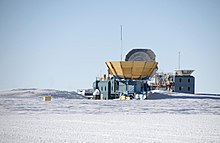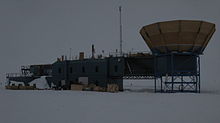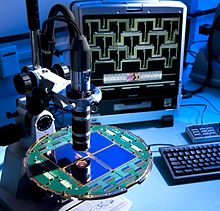Background Imaging of Cosmic Extragalactic Polarization
Background Imaging of Cosmic Extragalactic Polarization (BICEP) is an experiment to measure the polarization of cosmic microwave background radiation (CMB) in the Antarctic . The different stages of the experiment each consist of microwave antennas with polarization- sensitive bolometers . In addition to BICEP, the system of telescopes at the South Pole also includes the Keck Array .
construction
The experiment included BICEP1 (operated from January 2006 to December 2008, with 98 detectors) and BICEP2 (January 2010 to December 2012, with 512 detectors). BICEP3 (2560 detectors) and the Keck Array have been operating since 2015 (since 2011 initially with three, since 2012 with a total of five receiver units of the type used in BICEP2, each with 512 detectors). The BICEP telescope is located not far from the Amundsen-Scott South Pole Station in the Dark Sector Laboratory , where the South Pole Telescope is also housed. The Keck Array is located on the neighboring Martin A. Pomerantz Observatory (MAPO). An area around the south celestial pole is observed at frequencies of 95 (BICEP3) or 95, 150 and 220 GHz (Keck Array) .
Involved are the Caltech and Jet Propulsion Laboratory , Cardiff University , the University of Chicago , the Harvard-Smithsonian Center for Astrophysics , the CEA Grenoble (France), the University of Minnesota , Stanford University , the University of California, San Diego (BICEP1, BICEP2), the National Institute of Standards and Technology (NIST), the University of British Columbia and the University of Toronto (Canada, BICEP2, BICEP3, Keck Array) and Case Western Reserve University (Keck Array).
Lead scientists from BICEP and Keck Array are John Kovac (Harvard Smithsonian Center), Jamie Bock (Caltech, Jet Propulsion Laboratory), Clem Pryke (University of Minnesota), and Chao-Lin Kuo (Stanford / SLAC).
Message about the confirmation of cosmological inflation and gravitational waves by BICEP
The systems were specially designed to discover the so-called B-mode in the CMB, the "reverberation" of gravitational wave signals in the Cosmic Gravitational Wave Background (CGB) from the early inflationary phase of the universe , which has its traces in the distribution pattern of the polarization CMB as a special "turbulence component" left behind. The BICEP2 collaboration announced the discovery of B-mode in the CMB in March 2014. The B-mode is a signature for events in the universe that took place in the inflation period up to about 10 −31 seconds after the big bang and thus the earliest look into the universe. The CMB itself came from the time of the recombination of electrons and protons around 380,000 years after the Big Bang, when radiation and matter decoupled. The discovery of the primordial B-modes was one of the main goals of cosmological research. They provide both the first images of gravitational waves and the inflationary phase of the universe and have been described in popular science as the birth cry of the universe . The signal was stronger than expected by the theorists with a parameter r = 0.2, where r indicates the ratio of tensor to scalar amplitudes (the tensor amplitude comes from gravitational waves, the scalar amplitude from density fluctuations). Before the discovery of a B-mode signal was announced, the data were carefully analyzed for three years in order to exclude errors and their origin from later distortions, for example from the dust masses or synchrotron radiation in our galaxy. One of the main reasons for installing the telescopes at the South Pole was to avoid atmospheric interference with the measurement. BICEP was able to observe a particularly undisturbed area of the southern sky (Southern Hole) around the clock during the several months of polar night , although it was only around 2 degrees in extent. After the results were announced, independent confirmation of the results was awaited, for example by the Planck space telescope , which, unlike BICEP, also covers the entire sky and measures at different frequencies. The Planck telescope also provides more precise information, for example about the gravitational lens background, which must be deducted from the measurements.
In September 2014, the Planck Collaboration (Planck Telescope) published an interim analysis of their data, according to which the BICEP2 data in question could have been caused by polarized thermal radiation from interstellar dust in the Milky Way , which is influenced by the Milky Way's magnetic field and its fluctuations. David Spergel (Princeton) and others had previously criticized the interpretation of the BICEP collaboration because, unlike the latter, they had not fully taken into account the advance information of the Planck telescope on distortions caused by cosmic dust. After the later publication of the Planck data, however, the competitive influence of the dust is greater than the authors of the BICEP2 collaboration assumed based on the prior information.
The analysis of the Planck data extrapolated observation results of the Planck satellite at 353 GHz, a frequency range in which the contribution of the dust dominates, down to the frequency of 150 GHz and the section of sky in which BICEP2 operated. It showed that the selected part of the sky was by no means one of the regions least affected by cosmic dust and that all of the observed B-mode signals there could possibly be caused by cosmic dust, with a positive or negative relative uncertainty of around a third of the result. The values of r = 0.2 originally favored by BICEP2, which correspond to large field inflation models, had to be reduced due to the analysis of the Planck values. A re-analysis of the upper limit for r is in progress (November 2014). Experiments that can detect B-mode signals with r <0.1 up to the range of r = 0.01 are in development ( Atacama Cosmology Telescope , South Pole Telescope, BICEP / Keck Array, the Spider balloon experiment). In addition, it is preferred to study regions of the sky that are relatively free of interference from cosmic dust, and to use a wider range of frequencies. BICEP2 worked at 150 GHz, not least for metrological reasons; however, the observation of the spectrum at several frequencies allows better conclusions to be drawn about the origin of the observed signal. If no indications of primordial B-modes were then seen, inflation models would not be fundamentally excluded, but certain cosmological models derived from string theory ( Eva Silverstein , with predicted r = 0.07).
In January 2015, the discovery was officially withdrawn by the researchers after a final comparison with data from the Planck satellite.
literature
- D. Barkats et al. a .: Degree-Scale CMB Polarization Measurements from Three Years of BICEP1 Data. Astrophysical Journal, Arxiv 2013 (results from BICEP1)
- PAR goodbye u. a .: BICEP2 I: Detection Of B-mode Polarization at Degree Angular Scales. , Phys. Rev. Lett., Volume 112, 2014, p. 241101, Arxiv 2014 (discovery of the B-mode)
- PAR goodbye u. a .: BICEP2 II: Experiment and Three-Year Data Set , Astroph. J., Volume 792, 2014, 62, Arxiv
Web links
- Website of the research project at Harvard University
- Publications on the results of individual experiments
- Markus Pössel: BICEP2, Inflation, Cosmology: An Expert Opinion Scilog, March 29, 2014.
- Markus Pössel: BICEP2 update: What about inflation and gravitational waves? Scilog, March 23, 2014.
- Markus Pössel: BICEP2 and the first fractions of a second after the Big Bang. Scilog, March 17, 2014.
- Sean Carroll: Gravitational waves in the cosmic microwave background. March 16, 2014.
- Sean Carroll: BICEP2 Updates , March 16, 2014.
Footnotes
Remarks
- ↑ The B comes from the analogy to the magnetic field , since in contrast to the E-field configurations it is always source-free and consequently represents a "vortex field", mathematically thus formed with the rotation operator of vector analysis (hence also curl-mode in English called). The E-mode is the analogue of the electric field , which is always free of eddies in electrostatics as well as in the close range of electric dipole radiation and can therefore be defined via the gradient. The E-mode from the time shortly before the recombination (time of the last scattering before the decoupling of radiation and matter) had already been demonstrated by the DASI experiment (Degree Angular Scale Interferometer) in 2002, the predecessor of BICEP. The E-mode provides information on the gradient of the speed of the plasma before decoupling and thus on the density fluctuations. The B-mode was discovered by the competing South Pole Telescope as early as 2013, but the B-modes discovered at that time came from gravitational lens effects and were therefore not of primordial origin like the B-modes detected by BICEP, which were also superimposed by gravitational lens contributions and other effects are.
- ↑ For a clear representation of E and B modes see z. B. Shari Balouchi: Seeking the cosmic dawn Sky and Telescope, July 31, 2013.
- ↑ Because of the observations at the South Pole from the South Pole, the stars never set there.
Individual evidence
- ↑ BICEP1 . At cfa.harvard.edu, accessed March 26, 2018
- ↑ BICEP2 . At cfa.harvard.edu, accessed March 26, 2018
- ↑ BICEP3 Overview . At cfa.harvard.edu, accessed March 26, 2018
- ↑ Keck Array Overview . At cfa.harvard.edu, accessed March 26, 2018
- ↑ Kate Alexander: MAPO Open House . On December 14, 2014 from kateinantarctica.wordpress.com, accessed on March 22, 2018
- ↑ Ahmed Zeeshan: Updates from the BICEP / Keck Array Collaboration , p. 24 ff. On June 8, 2015 at workshops.ift.uam-csic.es, accessed on March 26, 2018 ( PDF , approx. 16.72 MB)
- ↑ Stuart Clark: Gravitational waves: have US scientists heard echoes of the big bang? . On March 14, 2014 from theguardian.com, accessed March 26, 2018
- ^ First Direct Evidence of Cosmic Inflation. . On March 17, 2014 from cfa.harvard.edu, accessed on March 26, 2018
- ↑ Felicitas Mokler: fingerprint of inflation measured . On March 18, 2014 from pro-physik.de, accessed on March 26, 2018
- ↑ Max Rauner, Ulrich Schnabel: Big Bang: The birth cry of the universe reaches the earth . On March 17, 2014 from zeit.de, accessed on March 26, 2018
- ^ R. Adam et al .: Planck intermediate results. XXX. The angular power spectrum of polarized dust emission at intermediate and high Galactic latitudes . On December 8, 2014 from arxiv.org, accessed March 26, 2018
- ↑ Natalie Wolchover: 'Big Bang Signal' Could All Be Dust. (No longer available online.) In: Quanta Magazine. simonsfoundation.org, September 22, 2014, archived from the original on September 22, 2014 ; accessed on March 26, 2018 .
- ↑ Peter Byrne: A Bold Critic of the Big Bang's 'Smoking Gun' July 3, 2014 at quantamagazine.org, accessed March 26, 2018
- ^ Breakdown at the South Pole. Der Spiegel, No. 41, 2014, 122–124
- ^ Liam McAllister, Eva Silverstein, Alexander Westphal: Gravity Waves and Linear Inflation from Axion Monodromy . On August 5, 2008 from arxiv.org, accessed March 26, 2018
- ^ Daniel Baumann et al .: CMBPol Mission Concept Study: Probing Inflation with CMB Polarization . March 14, 2009 from arxiv.org, accessed March 26, 2018
- ↑ Ron Cowen: Gravitational waves discovery now officially dead . On January 30, 2015 from nature.com, accessed on March 26, 2018



